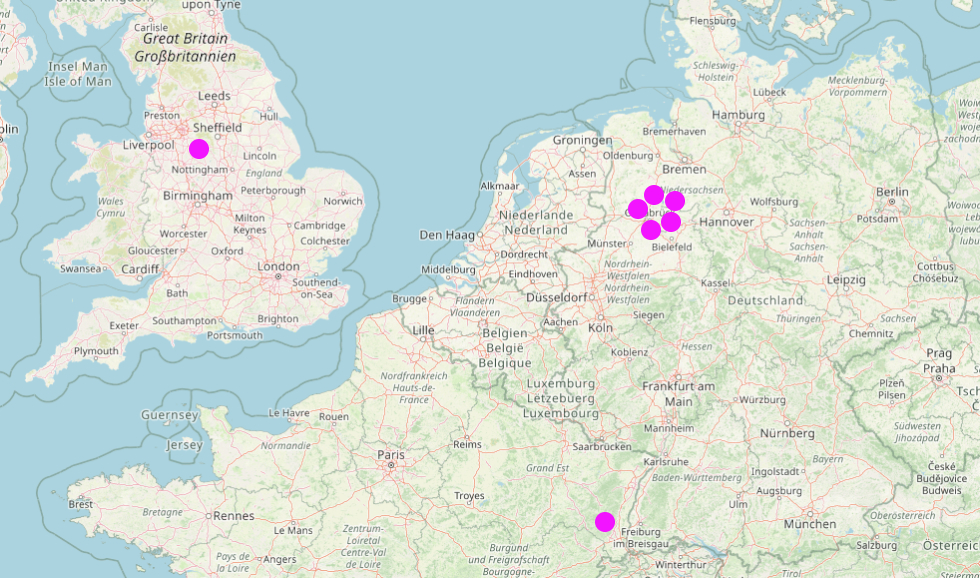It was a special night from May 10th to 11th, 2024. The Space Weather Prediction Center of the NOAA (National Oceanic and Atmospheric Administration) had already predicted a solar storm of category G4 (servere)* on May 9th, 2024, which was a fabulous event Kp value** of 8 or even 9 corresponds. With these values, northern lights should also be visible in our latitudes and further south.
All kosmos-os members waited eagerly. Would the weather hold? It lasted! Not only here in the Osnabrück region, but also in holiday areas where two of our members stayed.
The northern lights also kept what the Kp value had promised. It was a magnificent show in the sky! On the map below, the purple dots mark each observation location. Clicking on them takes you to the photos that were taken there and a short comment from the enthusiastic observer.
Positions of the kosmos-os observers on the night of May 10th/11th, 2024
Origin of the northern lights
The origin of the northern lights lies in the sun. The sun continuously emits a stream of charged particles called the solar wind. This solar wind consists mainly of electrons and protons that are thrown into space at high speeds. When these charged particles come close to the Earth, they are guided by the Earth's magnetic field along the field lines towards the polar regions. There they enter the Earth's upper atmosphere and collide with the gases present there, mainly oxygen and nitrogen. During these collisions, the gas atoms in the atmosphere are excited. The electrons in the atoms absorb energy and jump to higher energy levels. When these electrons return to their original state, they release the energy they have absorbed in the form of light. This light is what we see as the Northern Lights.
The colors of the northern lights vary depending on the type of gas atoms excited and the depth of penetration of the charged particles into the atmosphere. Oxygen can emit green or red light, while nitrogen produces blue or violet tones. Green light is most commonly seen in the polar regions, where the magnetic field lines enter or leave the earth and the guided particles reach very deep, as it is generated by oxygen between around 100 and 400 kilometers in altitude. Red light arises at higher altitudes, while blue and violet colors come from nitrogen atoms in the lower layers of the atmosphere.
The intensity and frequency of the northern lights depend heavily on solar activity. This year we are at peak activity. With the now numerous solar flares or coronal mass ejections, many charged particles are thrown towards Earth, so-called solar storms, which leads to intense and frequent aurora borealis. These events occur in the eleven-year solar cycle.
The solar storm of 10/11 May had its origins in a huge sunspot group that had very active areas.
Sun in white light, May 10, 2024, Photo: Thomas Kunzemann Sun in white light, detail with the spot group AR 3664, May 10, 2024, Photo: Thomas Kunzemann The development of the spot group AR 3664 on May 2, 4, 5, 6, 8, 9, 10, 11, 12, 13 and 14, 2024, photos: Thomas Kunzemann
_____________________________________________________________
*
Graphical representation of NOAA space weather warnings (queried on May 15, 2024, 6 p.m. UTC)
The predictions and history can be accessed via this link: https://www.swpc.noaa.gov/products/notifications-timeline . You can also put yourself on a mailing warning list. The geomagnetic factors are described by NOAA as follows:
1. G1 – Minor: Minor impacts to the power grid may occur, particularly at high latitudes where power lines extend. Communication systems may also be affected, particularly in near-polar regions. Satellite operations may be affected.
2. G2 – Moderate: At this level, high latitude power grids may temporarily fail or become overloaded. Satellite operations may be disrupted and certain GPS navigations may become unreliable. Communication on high frequency bands may be affected.
3. G3 – Strong: In this case, large portions of high-latitude power grids may be affected, leading to voltage instability and possible outages. Satellites can be disrupted, resulting in temporary outages of satellite services. GPS can become unreliable.
4. G4 – Very Strong (Severe): This is the highest level on the scale. Widespread power outages can occur here, lasting days to weeks. Satellite communications and navigation can be significantly disrupted. Radio frequency communications may be affected and increased radiation levels may occur in polar regions.
These factors are important for understanding the potential impacts of space weather events on various systems on Earth and taking appropriate precautions.
**p lanetarische K ennziffer. More Infomation here:
https://www.gfz-potsdam.de/en/section/geomagnetism/data-products-services/geomagnetic-kp-index
--> All our reports about auroras
